
An essential property of impossible objects is that they may be interpreted locally as three-dimensional objects. Because, at least to a great extent, geometry considers the world locally (“in the small”), it is not surprising that they are mathematical objects. The impossible tribar has an interesting geometry. For instance, let a lady-bird run in longitudonal direction over the bars, see the figure on the left. The transitions in the middle of each bar area are numbered, the course is indicated with arrows. Now the surface of the impossible tribar seems to consist of a long continuous band. After 4 circulations the lady-bird has returned to its starting point.
The surface of an impossible tribar (without edges) is a closed orientable two-dimensional manifold. The three parts sketched in the figure can be considered as three coordinate charts.

Even more: The interior of the impossible tribar is a three-dimensional orientable maninfold. We even may calculate its volume, as the figure on the right indicates. The tribar is composed of 12 numbered cubes with well-defined volumes. Hence, the volume for instance is 12 m3, if the 12 parts are unit cubes with side length 1 m.
Conclusion: Local considerations of an impossible object work without any contradiction. The retina picture of an impossible object therefore is treated by our mind in just the same way than a picture of a chair or a house: It is a “spatial picture”. At this stage there is no difference between, say, an impossible tribar and a chair. “The impossible tribar thus exists in the depth of our mind, on the same level as all objects of the world surrounding us.” (Bruno Ernst, 1989)
“Human beings are genetically equipped to understand mathematical structures.” (Hans Magnus Enzensberger) And vice versa: The mathematical structures are the formal expression of our genetical equipment. The mathematical concepts and ideas emerged, eventually, from our minds and from the millions of years old heritage of evolution, by which a specific kind perception of the world, well-adapted to the life conditions of our ancestors.